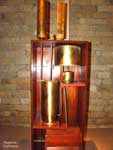.
The long unmeasured pulse of time moves everything. There is nothing hidden that it cannot bring to life, nothing once known that may not become unknown. Sophocles, Ajax
The first clock probably recognized by humans was the sky in the simplest form first by the day and night period. Various observations of the sky were used as a clock. Hesiod around 750 BC tells farmers when to carry certain activities based on the position of different stars. Time was measured for example by the apparent motion of the sun using sundials.
He also was the first discoverer of the gnomon; and he placed some in Lacedaemon on the sun-dials there, as Favorinus says in his Universal History, and they showed the solstices and the equinoxes; he also made clocks. He was the first person, too, who drew a map of the earth and sea, and he also made a globe; Diogenes Laertius, Life of Anaximander
The time flow is a mystery and physicist believe that time is an illusion. But were comes the word that “time flows”? Probably from the water clock, a tank holding water, with a very small hole in its bottom, from which the water slowly drips. The level of water sinks and its height is a measure of the time passed since it was full of water. As Heron of Alexandria says the amount of water flown is proportional to the time (as the water to water so the time to time):
κατασκευάζεται γὰρ ἀγγεῖόν τι ἔχον ὀπὴν ὡς ἂν κλεψύδρα, δι᾽ ἧς ὁμαλῶς, ὡς ἔθος, δύναται τὸ ὕδωρ ἐκρεῖν. ὅπερ προκατασκευάζεται τὴν ἀρχὴν τῆς ἐκρύσεως ἔχον ὅτε πρῶτον ἐκ τοῦ ὁρίζοντος ὁ ἥλιος τὴν πρώτην ἀκτῖνα προσβάλλει, καὶ τὸ ῥεῦσαν ὕδωρ ἐν ὧι χρόνωι ὁ δίσκος ὑπὲρ τὸν ὁρίζοντα γίνεται φυλάττεται χωρίς, εἶτα τὸ ἐφεξῆς ἐν ὅλωι τῶι νυχθημέρωι μέχρι τῆς ἑτέρας ἀνατολῆς ὁμαλῶς καὶ ἀνεκλείπτως καὶ ἀπαύστως ῥυὲν ἐν ἑτέρωι ἀγγείωι· καὶ τὸ ῥεῦσαν παραμετρεῖται, ποσαπλάσιόν ἐστι τοῦ κατὰ τὴν ἀνατολὴν ληφθέντος ὕδατος· καὶ τοῦτὸ ἔσται ἀνάλογον τῶι χρόνωι· καὶ ὡς τὸ ὕδωρ πρὸς τὸ ὕδωρ, οὕτως ὁ χρόνος πρὸς τὸν χρόνον. Ἥρων ὁ Ἀλεξανδρεύς, Περὶ ὑδρίων ὡροσκοπείων from Textus: Heronis opera quae supersunt omnia ed. W. Schmidt/L. Nix/H. Schöne/J. L. Heiberg Leipzig 1899 sqq. http://www.fh-augsburg.de/~harsch/graeca/Chronologia/S_post01/Heron/her_hora.html
The problem is that the flow of water depends on how much water is in the container.
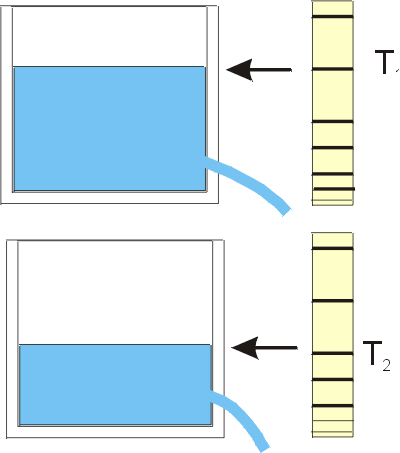
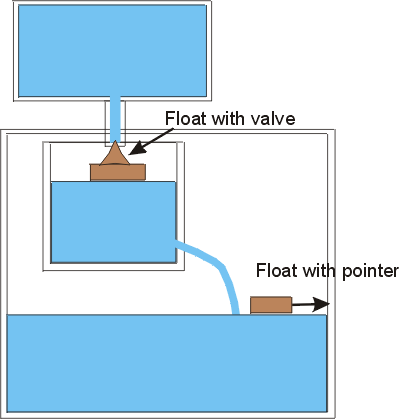
Ctesibius invented probably one of the first controlled systems in history. Possibly the earliest ancestor of today's industrial-robot devices is the clepsydra (κλεψύδρα, "water thieve") or water clock (pronounced as “klep-suh-druh”), which improved upon the hourglass by employing a siphon principle to automatically recycle itself. Like Ctesibius also Philon of Byzantium used a similar float regulator mechanism to keep a constant level of oil in a lamp.
Waterclocks were built in China (1086 by Su Sung, a working model can be seen in action in the Manor House Museum UK), Korea (architect: Chang Yeong Shil, 1438, can still be seen at Kyeong Bok Gung.), Egypt (1500 BC) and in Syria (700 BC). Greece (ca. 5th century BC ) Ctesibius is reputed to have constructed such a clock about 250 BC. He used another container to fill the container from which the water flows keeping its water level constant though a floater that opens a valve if the water falls below a level. The water now is collected in another container outside and its level shows the time for example using a floater with a pointer on a calibrated time scale.
Although simple and fair, it was somewhat imprecise. Ctesibius wanted to transform the clepsydra from a device to indicate the end of a given time into a continuously working clock. He noticed that the water dripped out faster when the jar was full, slowing as it emptied. Consequently it was of no use for displaying time during the process. His simple solution was to ensure the jar was always full. He introduced a second container with a bigger hole, which dripped faster to ensure the clepsydra remained full and so dripped at a constant rate. A clepsydra that never emptied was of no value, however, so he had to find a way to measure the water that came out, and for this he used a float with a pointer in a third container.
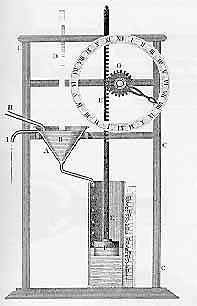
Water drips from the higher container to the lower container. As the water level rises in the lower container, it raises the float on the surface of the water. The float is connected to a stick with notches, and as the stick rises, the notches turn a gear, which moves the hand that points to the time.
On the water, the floating rack could turn a toothed wheel to a number of “parerga: whistling birds, moving puppets, ringing bells, and the like.”, but this did not work. Afterwards, he reconstructed the water clock and this time he made a pointer, which moved at steady rate. This pointer would mark hours at different length of lines traced on a vertical cylinder. In the 16th century AD the clepsydra was used by Galileo to time his experimental falling objects.
This invention is similar to the mechanism used in the 20th-century flush toilet. The floating valve is the predecessor of the floating ball in the upper chamber of the toilet. After a flush, the floating ball sinks with the declining water level, pulling open the water valve with its metal arm. The incoming water fills the vessel again, raising the ball so that its arm closes the flow of water at the precise level of "full.
Ctesibius was also responsible for transforming a legal device into a clock so accurate that it would not be surpassed until the seventeenth century. In Alexandrian courtrooms a defendant was permitted to speak for a certain regulated time. The device they used to ensure fairness was the clepsydra - 'captured water' - and was a simple jar with a hole. A specific quantity of water - measured according to the crime - was poured into the container and the defendant could speak until the water ran out.
Ctesibius invented other less known devices, but the most important invention is the principle of pumping air to make other things work
A Macedonian astronomer, Andronikos of Kyrrhos (or Cyrrhestes) (Ανδρόνικος ο Κυρρήστης), supervised the construction of the Horologion according to Vitruvius, known today as the Tower of the Winds, in the Athens marketplace in the first half of the first century BC. This octagonal structure showed scholars and shoppers both sundials and mechanical hour indicators. It featured a 24 hour mechanized clepsydra and indicators for the eight winds from which the tower got its name, and it displayed the seasons of the year and astrological dates and periods. The clepsydra inside was driven by water from the acropolis. The Romans also developed mechanized clepsydras, though their complexity accomplished little improvement over simpler methods for determining the passage of time. More accurate mechanical clocks using falling weights instead of water appeared in the fourteenth century, and the ingredients for the modern clock were in place when Galileo described the pendulum in the sixteenth century. The word Clock was not used until the 14th century. However, it was not until 1657 that the Dutch physicist Christiaan Huygens showed how a pendulum could be used to regulate a clock, and only then was the first mechanical clock more accurate than that of Ctesibius, invented some 1800 years previously.
D de Solla Price & J V Noble ‘The water clock in the Tower of the Winds’ AJA 72 (1968) 345-55
Interesting are reports that physicians used portable clepsydrae to measure the pulse of patients. (Peters, Arno: Synchronoptische Weltgeschichte. Grundband, München, 1970 in German)
Archimedes wrote a book about clocks that was translated in the 9th century in Arabic. After more than 2000 years it was translated again in Greek by Evangelos Stamatis.
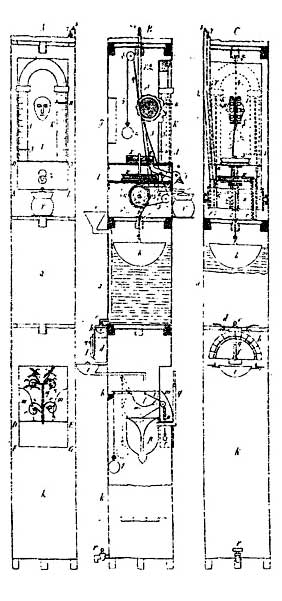
Hydraulic Clock of Archimedes, E. Widemann, F. Hauser, Nova Acta, Deutsche Akademie der Naturforscher, 1918
See also
Citations
I will tell you in the course of my speech, if you care to hear and if the water in the water-clock holds out. Demosthenes in Apollodorus against Neaera
For water continually dropping will wear hard rocks hollow, PlutarchAn animation of the Clepsydra
Time Machines
| Ancient Greece
Science, Technology , Medicine , Warfare, , Biographies , Life , Cities/Places/Maps , Arts , Literature , Philosophy ,Olympics, Mythology , History , Images Medieval Greece / Byzantine Empire Science, Technology, Arts, , Warfare , Literature, Biographies, Icons, History Modern Greece Cities, Islands, Regions, Fauna/Flora ,Biographies , History , Warfare, Science/Technology, Literature, Music , Arts , Film/Actors , Sport , Fashion --- |

